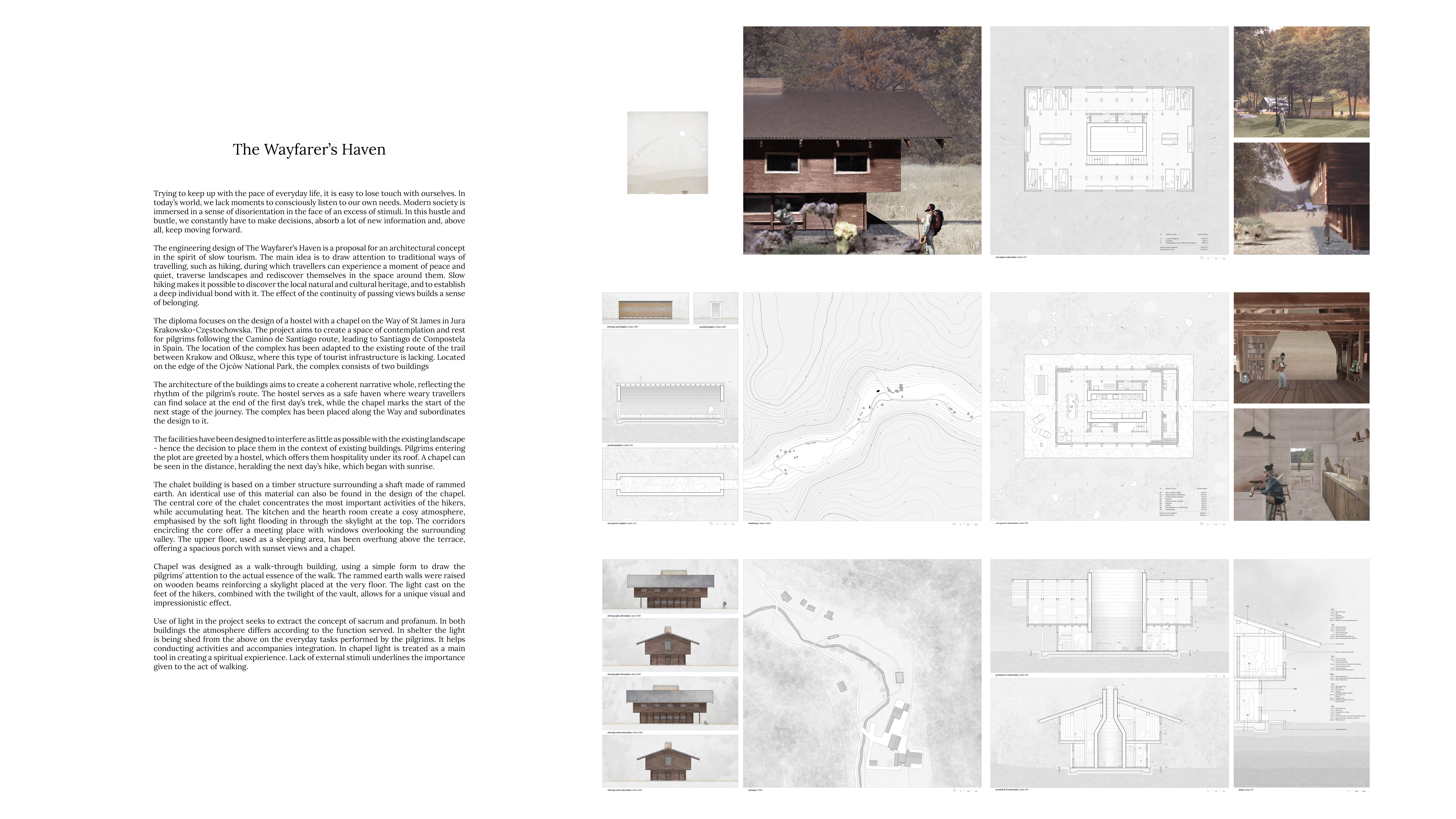2024 - The Wayfarer’s Haven

Category
Daylight in Buildings - Region 2: Eastern Europe and The Middle East
Students
Agnieszka Wiecha
Teacher
Mirosław Orzechowski
School
Politechnika Warszawska
Country
Poland
Download
Download project board
Trying to keep up with the pace of everyday life, it is easy to lose touch with ourselves. In today’s world, we lack moments to consciously listen to our own needs. Modern society is immersed in a sense of disorientation in the face of an excess of stimuli. In this hustle and bustle, we constantly have to make decisions, absorb a lot of new information and, above all, keep moving forward.
The engineering design of The Wayfarer’s Haven is a proposal for an architectural concept in the spirit of slow tourism. The main idea is to draw attention to traditional ways of travelling, such as hiking, during which travellers can experience a moment of peace and quiet, traverse landscapes and rediscover themselves in the space around them. Slow hiking makes it possible to discover the local natural and cultural heritage, and to establish a deep individual bond with it. The effect of the continuity of passing views builds a sense of belonging.
The diploma focuses on the design of a hostel with a chapel on the Way of St James in Jura Krakowsko-Częstochowska. The project aims to create a space of contemplation and rest for pilgrims following the Camino de Santiago route, leading to Santiago de Compostela in Spain. The location of the complex has been adapted to the existing route of the trail between Krakow and Olkusz, where this type of tourist infrastructure is lacking. Located on the edge of the Ojców National Park, the complex consists of two buildings.
The architecture of the buildings aims to create a coherent narrative whole, reflecting the rhythm of the pilgrim’s route. The hostel serves as a safe haven where weary travellers can find solace at the end of the first day’s trek, while the chapel marks the start of the next stage of the journey. The complex has been placed along the Way and subordinates the design to it.
The facilities have been designed to interfere as little as possible with the existing landscape – hence the decision to place them in the context of existing buildings. Pilgrims entering the plot are greeted by a hostel, which offers them hospitality under its roof. A chapel can be seen in the distance, heralding the next day’s hike, which began with sunrise.
The chalet building is based on a timber structure surrounding a shaft made of rammed earth. An identical use of this material can also be found in the design of the chapel. The central core of the chalet concentrates the most important activities of the hikers, while accumulating heat. The kitchen and the hearth room create a cosy atmosphere, emphasised by the soft light flooding in through the skylight at the top. The corridors encircling the core offer a meeting place with windows overlooking the surrounding valley. The upper floor, used as a sleeping area, has been overhung above the terrace, offering a spacious porch with sunset views and a chapel.
The chapel was designed as a walk-through building, using a simple form to draw the pilgrims’ attention to the actual essence of the walk. The rammed earth walls were raised on wooden beams reinforcing a skylight placed at the very floor. The light cast on the feet of the hikers, combined with the twilight of the vault, allows for a unique visual and impressionistic effect.
Use of light in the project seeks to extract the concept of sacrum and profanum. In both buildings the atmosphere differs according to the function served. In the shelter, the light is being shed from above on the everyday tasks performed by the pilgrims. It helps conduct activities and accompanies integration. In the chapel, light is treated as a main tool in creating a spiritual experience. Lack of external stimuli underlines the importance given to the act of walking.
The design of the complex is rooted in the philosophy of vernacular architecture, emphasised through the use of local materials and typological consistency. Great attention has been paid to fitting the architecture into the natural context, respecting the unique location. The design of the chalet pays homage to the Swiss-Father style, derived from the spa tradition of the region. The modest form of the chapel, on the other hand, tries not to compete for attention with the imposing landscape.

























